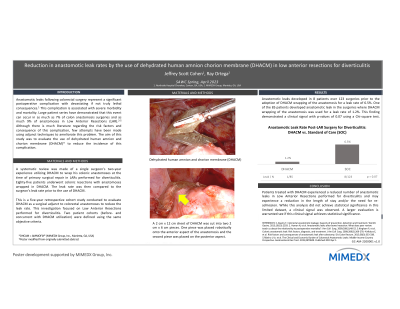Clinical Research
(CR-036) Reduction In Anastomotic Leak Rates By The Use Of Dehydrated Human Amnion Chorion Membrane (DHACM) In Low Anterior Resections For Diverticulitis
Friday, April 28, 2023
7:15 PM - 8:30 PM East Coast USA Time

Ray Ortega, MD; William Tettelbach, MD, FACP, FIDSA, FHUM, MAPWCA, CWSP – Executive Medical Director of Wound & Hyperbaric Service Line/Adjunct Assistant Professor, HCA Healthcare/Duke University School of Medicine
Introduction:
Anastomotic leaks following colorectal surgery represent a significant postoperative complication with devastating if not lethal consequences. This complication is associated with severe morbidity and mortality. Large patient series have demonstrated that this event can occur in as much as 7% of colon anastomosis surgeries and as much 9% of anastomoses in Low Anterior Resections (LAR). Despite medical literature highlighting the risk factors and consequences of this complication, few effective attempts have been made using adjunct techniques to ameliorate this problem. The aim of this study was to evaluate the use of dehydrated human amnion and chorion membrane (DHACM) allografts to reduce the incidence of this complication.
Methods:
This five-year retrospective cohort study was conducted to evaluate the favorable impact of DHACM as a surgical adjunct to colorectal anastomoses on reducing the post-procedure leak rate of LARs performed for diverticulitis. A propensity-matched retrospective cohort methodology was used to define two therapeutic groups applying the same objective criteria. The groups included those with diverticulitis that did not receive DHACM and those with diverticulitis who did receive DHACM during the LARs. Within the five-year range, the analysis incorporated a single surgeon’s two-year experience using DHACM to wrap colonic anastomoses at the time of the primary surgical repair.
Results:
Anastomotic leaks developed in eight cases over 123 surgeries prior to the adoption of DHACM wrapping of the anastomosis (post-procedure leak rate 7%). None of the 85 patients developed an anastomotic leak in the surgeries deploying DHACM wrapping of the anastomosis (post-procedure leak rate 0%). This finding is statistically significant with p-values of 0.02 for both Fisher and Chi-square tests.
Discussion:
Patients treated with DHACM were observed to experience a reduced number of anastomotic leaks in Low Anterior Resections performed for diverticulitis. This favorable impact, if widely adopted, could potentially lead to an overall reduction in length of stay and/or the need for re-admission. Further research in this area is warranted to corroborate the presented findings while concomitantly drive future adoption of this adjunctive technique to improve patient outcomes.
Anastomotic leaks following colorectal surgery represent a significant postoperative complication with devastating if not lethal consequences. This complication is associated with severe morbidity and mortality. Large patient series have demonstrated that this event can occur in as much as 7% of colon anastomosis surgeries and as much 9% of anastomoses in Low Anterior Resections (LAR). Despite medical literature highlighting the risk factors and consequences of this complication, few effective attempts have been made using adjunct techniques to ameliorate this problem. The aim of this study was to evaluate the use of dehydrated human amnion and chorion membrane (DHACM) allografts to reduce the incidence of this complication.
Methods:
This five-year retrospective cohort study was conducted to evaluate the favorable impact of DHACM as a surgical adjunct to colorectal anastomoses on reducing the post-procedure leak rate of LARs performed for diverticulitis. A propensity-matched retrospective cohort methodology was used to define two therapeutic groups applying the same objective criteria. The groups included those with diverticulitis that did not receive DHACM and those with diverticulitis who did receive DHACM during the LARs. Within the five-year range, the analysis incorporated a single surgeon’s two-year experience using DHACM to wrap colonic anastomoses at the time of the primary surgical repair.
Results:
Anastomotic leaks developed in eight cases over 123 surgeries prior to the adoption of DHACM wrapping of the anastomosis (post-procedure leak rate 7%). None of the 85 patients developed an anastomotic leak in the surgeries deploying DHACM wrapping of the anastomosis (post-procedure leak rate 0%). This finding is statistically significant with p-values of 0.02 for both Fisher and Chi-square tests.
Discussion:
Patients treated with DHACM were observed to experience a reduced number of anastomotic leaks in Low Anterior Resections performed for diverticulitis. This favorable impact, if widely adopted, could potentially lead to an overall reduction in length of stay and/or the need for re-admission. Further research in this area is warranted to corroborate the presented findings while concomitantly drive future adoption of this adjunctive technique to improve patient outcomes.

.png)